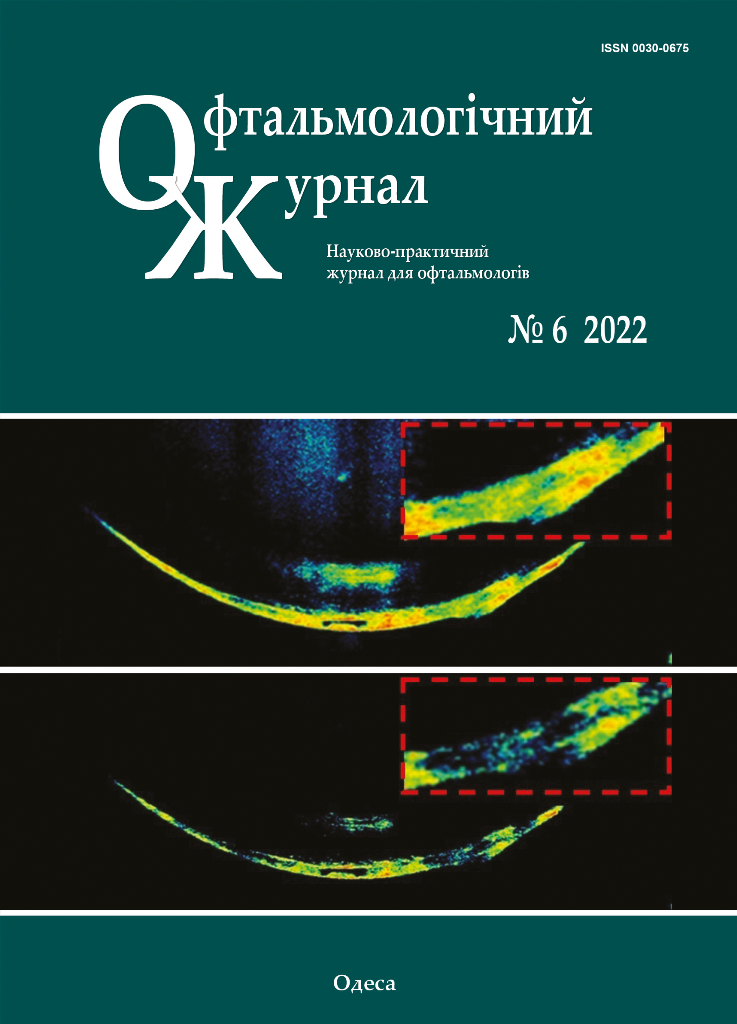Прогностичні фактори ризику розвитку діабетичної ретинопатії у хворих на цукровий діабет 2-го типу
DOI:
https://doi.org/10.31288/oftalmolzh202261923Ключові слова:
цукровий діабет, діабетична ретинопатія, органи-мішені, прогностичні маркериАнотація
Мета. Визначити взаємозв’язок розвитку діабетичної ретинопатії у пацієнтів із цукровим діабетом 2-го типу з ураженням інших органів-мішеней, тяжкістю захворювання, потребою в інсулінотерапії та визначити найбільш значущі прогностичні маркери.
Матеріал та методи. Обстежено 270 пацієнтів з цукровим діабетом 2 типу: 160 осіб з наявністю діабетичної ретинопатії та група порівняння – 82 пацієнта. Стан органів-мішеней визначений за консультаціями суміжних спеціалістів: ендокринолога, кардіолога, нефролога, невропатолога, судинного хірурга.
Результати. Визначено позитивний кореляційний зв’язок проміж наявністю діабетичної ретинопатії та тяжкої форми цукрового діабету (r=0,383, p<0,001), потребою в інсулінотерапії (r=0,389, p<0,001), розвитком діабетичної нефропатії (r=0,350, p<0,001), хронічної ниркової недостатності (r=0,390, p<0,001), ангіопатії нижніх кінцівок (r=0,312, p<0,001), ішемічною хворобою серця (r=0,155, p=0,011), гіпертонічною хворобою (r=0,149, p=0,014).
Відмічено збільшення шансів розвитку ретинопатії у хворих на інсулінотерапії (OR 6,1; 95% СІ 3,40-10,93), у пацієнтів з діабетичною нефропатією (OR 17,34; 95% СІ 4,94-60,83), хронічною нирковою недостатністю (OR 6,88; 95% СІ 3,66-12,94), ангіопатією нижніх кінцівок (OR19,15; 95% СІ 4,24-86,45), ішемічною хворобою серця (OR 2,4; 95% СІ 1,21-4,76) та гіпертонічною хворобою (OR 4,29; 95% СІ 1,22-15,10). Ризик розвитку діабетичної ретинопатії у хворих з тяжкою формою цукрового діабету підвищується в 5,79 разів (95% СІ 3,26-10,26) порівняно з хворими на діабет легкого або середнього ступеня тяжкості.
Висновки. Визначено найбільш тісний позитивний кореляційний зв’язок та збільшення вірогідності розвитку діабетичної ретинопатії у хворих з нирковою недостатністю та нефропатією, ангіопатією нижніх кінцівок. Встановлений позитивний зв’язок середньої сили із тяжкою формою діабету та потребою в інсулінотерапії. Асоціація проміж наявністю діабетичної ретинопатії та гострих коронарних і мозкових порушень не мала статичної значущості.
Посилання
1.International Diabetes Federation. IDF Diabetes Atlas, 10th edn. Brussels, Belgium: 2021. Available at: https://diabetesatlas.org/atlas/tenth-edition/
2.International Council Of Ophthalmology. ICO Guidelines for Diabetic Eye Care (2017). Availble at: https://icoph.org/eye-care-delivery/diabetic-eye-care/
3.Cavan D, Makaroff L, da Rocha Fernandes J, Sylvanowicz M et al. The Diabetic Retinopathy Barometer Study: Global perspectives on access to and experiences of diabetic retinopathy screening and treatment. Diabetes Res Clin Pract. 2017 Jul; Volume 129:16-24. https://doi.org/10.1016/j.diabres.2017.03.023
4.Alifanov IS, Sakovych VN, Alifanova TO. Disability due to ocular complications of diabetes mellitus in Ukraine. J Ophthalmol (Ukraine). 2019;6:34-8. https://doi.org/10.31288/oftalmolzh201963438
5.Yau JW, Rogers SL, Kawasaki R, et al. Global prevalence and major risk factors of diabetic retinopathy. Diabetes Care. 2012;35(3):556-564. https://doi.org/10.2337/dc11-1909
6.Harris Nwanyanwu K, Talwar N, Gardner TW, Wrobel JS, Herman WH, Stein JD. Predicting development of proliferative diabetic retinopathy. Diabetes Care. 2013;36(6):1562-1568. https://doi.org/10.2337/dc12-0790
7.Brownrigg JR, Hughes CO, Burleigh D, et al. Microvascular disease and risk of cardiovascular events among individuals with type 2 diabetes: a population-level cohort study. Lancet Diabetes Endocrinol. 2016;4(7):588-597. https://doi.org/10.1016/S2213-8587(16)30057-2
8.Barlovic DP, Harjutsalo V, Gordin D, Kallio M, Forsblom C, King G, Groop P-H; on behalf of the Finn Diane Study Group, The Association of Severe Diabetic Retinopathy With Cardiovascular Outcomes in Long-standing Type 1 Diabetes: A Longitudinal Follow-up. Diabetes Care. 1 December 2018; 41 (12): 2487-94. https://doi.org/10.2337/dc18-0476
9.Hughes AD, Falaschetti E, Witt N, et al. Association of Retinopathy and Retinal Microvascular Abnormalities With Stroke and Cerebrovascular Disease. Stroke. 2016;47(11):2862-2864. https://doi.org/10.1161/STROKEAHA.116.014998
10.Hanff TC, Sharrett AR, Mosley TH, et al. Retinal microvascular abnormalities predict progression of brain microvascular disease: an atherosclerosis risk in communities magnetic resonance imaging study. Stroke. 2014;45(4):1012-1017. https://doi.org/10.1161/STROKEAHA.113.004166
11.Crosby-Nwaobi RR, Sivaprasad S, Amiel S, Forbes A. The relationship between diabetic retinopathy and cognitive impairment. Diabetes Care. 2013;36(10):3177-3186. https://doi.org/10.2337/dc12-2141
12.Foussard N, Saulnier P-J, Potier L, Ragot S, Schneider F, Gand E, et al.; on behalf of the SURDIAGENE Study Group, Relationship Between Diabetic Retinopathy Stages and Risk of Major Lower-Extremity Arterial Disease in Patients With Type 2 Diabetes. Diabetes Care 1 November 2020; 43 (11): 2751-2759. https://doi.org/10.2337/dc20-1085
13.Mohammedi K, Woodward M, Hirakawa Y, et al. Microvascular and Macrovascular Disease and Risk for Major Peripheral Arterial Disease in Patients With Type 2 Diabetes. Diabetes Care. 2016;39(10):1796-1803. https://doi.org/10.2337/dc16-0588
14.Pearce I, Simó R, Lövestam-Adrian M, Wong DT, Evans M. Association between diabetic eye diseaseand other complications of diabetes: Implications for care. A systematic review. Diabetes Obes Metab. 2019;21:467-78. https://doi.org/10.1111/dom.13550
##submission.downloads##
Опубліковано
Як цитувати
Номер
Розділ
Ліцензія
Авторське право (c) 2025 І. С. Аліфанов, В. М. Сакович

Ця робота ліцензується відповідно до Creative Commons Attribution 4.0 International License.
Ця робота ліцензується відповідно до ліцензії Creative Commons Attribution 4.0 International (CC BY). Ця ліцензія дозволяє повторно використовувати, поширювати, переробляти, адаптувати та будувати на основі матеріалу на будь-якому носії або в будь-якому форматі за умови обов'язкового посилання на авторів робіт і первинну публікацію у цьому журналі. Ліцензія дозволяє комерційне використання.
ПОЛОЖЕННЯ ПРО АВТОРСЬКІ ПРАВА
Автори, які подають матеріали до цього журналу, погоджуються з наступними положеннями:
- Автори отримують право на авторство своєї роботи одразу після її публікації та назавжди зберігають це право за собою без жодних обмежень.
- Дата початку дії авторського права на статтю відповідає даті публікації випуску, до якого вона включена.
ПОЛІТИКА ДЕПОНУВАННЯ
- Редакція журналу заохочує розміщення авторами рукопису статті в мережі Інтернет (наприклад, у сховищах установ або на особистих веб-сайтах), оскільки це сприяє виникненню продуктивної наукової дискусії та позитивно позначається на оперативності і динаміці цитування.
- Автори мають право укладати самостійні додаткові угоди щодо неексклюзивного розповсюдження статті у тому вигляді, в якому вона була опублікована цим журналом за умови збереження посилання на первинну публікацію у цьому журналі.
- Дозволяється самоархівування постпринтів (версій рукописів, схвалених до друку в процесі рецензування) під час їх редакційного опрацювання або опублікованих видавцем PDF-версій.
- Самоархівування препринтів (версій рукописів до рецензування) не дозволяється.












